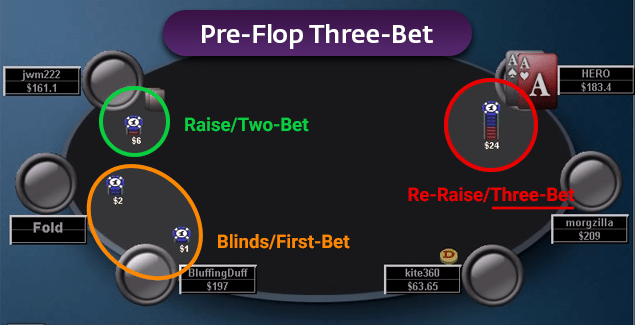The 3-bet (or more specifically, light 3-betting) is an advanced concept that adds an extra weapon to a game that has likely become repetitive and stagnant, even if that current game strategy is winning you money at the tables. Take a look at AK's equity vs one, two and three random poker hands: A 3-bet will usually force some players out before the flop, making it more likely that you will win the hand. 3-betting gives you a chance to pick up the pot preflop Calling an open-raise gives you no chance to pick up the pot preflop, but 3.
Specifying as gtree game

We specify the game in gtree as follows:

We specify the game in gtree as follows:
To better understand the definition and to check whether we have correctly specified the game, it is useful to take a look at the outcomes:
| card1 | card2 | cb1 | cb2 | fc2 | fc1 | folder | winner | gave1 | gave2 | pot | payoff_1 | payoff_2 | util_1 | util_2 |
|---|---|---|---|---|---|---|---|---|---|---|---|---|---|---|
| 1 | 2 | check | check | NA | NA | 0 | 2 | 1 | 1 | 2 | -1 | 1 | -1 | 1 |
| 1 | 2 | check | bet | NA | fold | 1 | 2 | 1 | 2 | 3 | -1 | 1 | -1 | 1 |
| 1 | 2 | check | bet | NA | call | 0 | 2 | 2 | 2 | 4 | -2 | 2 | -2 | 2 |
| 1 | 2 | bet | NA | fold | NA | 2 | 1 | 2 | 1 | 3 | 1 | -1 | 1 | -1 |
| 1 | 2 | bet | NA | call | NA | 0 | 2 | 2 | 2 | 4 | -2 | 2 | -2 | 2 |
| 1 | 3 | check | check | NA | NA | 0 | 2 | 1 | 1 | 2 | -1 | 1 | -1 | 1 |
Look at the first row. We see from cb1 and cb2 that this corresponds to an outcome in which both players check. The variables fc2 and fc1 take NA values because there is no decision to fold or call if both players check.
Formulas in the game definition will be internaly evaluated in a vectorized fashion over similar data frames and may take NA values. The helper function is_true takes a logical vector and replaces NA values with FALSE. I use this function in the game definition where a condition must evaluate to either TRUE or FALSE while NA values are not allowed.
You may also take a look at the definition of card2 in the first stage. Here the set of the random variable is a formula and depends on the previously computed value of card1.
Let us also take a look at the game size:
While the number of pure strategy profiles is not really small, the game still seems of tractable size for numerical analysis.
Three betting is a necessity in most any game to one degree or another, but 3-bet folding can cost you a lot of money. There are certain situations where it will drain your bankroll and other spots where it is the only reasonable play. As is the case with most any play in poker, there are a number of variables that you will need to take into consideration. It is first important to realize that much of the post-flop decision making is going to be largely determined by how you played the hand pre-flop. If you are going nuts with big plays pre-flop, you better be willing to commit post-flop as well. What many players fail to realize is that pre-flop play really is the framework for tough post-flop decisions.
Bet Online Poker Download
Stack sizes are almost always the primary factor when deciding whether or not you are in a position where 3-bet folding is viable. If you are playing with a deeper stack, there is a better chance that there will be room to let go of your hand. When you are working with a shorter stack, however, it will be harder to find a 3-bet fold that makes financial sense. Aside from stack sizes, position and your opponents will also factor into your final decision. Deciding your next move after facing a 4-bet should not be all that difficult, especially after you know what to look for.
Pre-Flop Scenarios
There are almost infinite different ways that you could be set up against a 4-bet. The best spot to be in is late position against just one opponent. This is as simple as it gets and gives you a significant advantage against your opponents. The worst scenario is a 3-bet in the blinds that ends up facing an eventual 4-bet. Needless to say, your decision should be much easier in late position than it is when you are in the blinds.
The biggest mistake that you can make with 3-bets is making one at all. If this doesn't make sense, just think about it for a second. If you are in the small blind or big blind with TT or JJ, you may very well be stuck and not know what to do. A lot of players think that 3-betting here makes sense because it will allow them to 'see where they are.' While this may be true, it is also a complete waste of money. If you re-raise with JJ in the SB and force folds, you know that you were ahead. If you re-raise and get 4-bet, you put yourself in a terrible spot. Now you need to decide whether to call, fold, or shove. It would make a lot more sense to simply see a flop and play the hand from there. This isn't the most comfortable hand to play out of position, there is no arguing that, but it is much better than either wasting money or losing value.
You should always know exactly what you are going to do if you get 4-bet whenever you make a 3-bet. It seems that this should go without saying, but a lot of players truly do play their hands with no real game plan in place. I would be willing to bet that if you considered what you are going to do if you get re-raised, you will have a much better time overall and will be in a lot less tough spots. If you know what your next move is, you can scale your immediate play accordingly. For example, if you have decided that you are going to fold to a 4-bet, you can make your 3-bet a bit smaller so as to save yourself a little bit of money. If you keep your bet the normal size and actually want a 4-bet, there is nothing else that you can do but sit back and hope for the best. Scale your bets so that your later plans are factored into the end game equation. Saving a couple bucks here and there is a great way to boost your win rate in the long run.
When You Should (Can) Fold
The situations where folding a 3-bet hand is viable are much less frequent than those where you shouldn't fold. Assuming normal stack sizes, most 3-bets are going to require 10-30% of your total chips, and it is usually closer to the higher end of that figure. Say that you are in a $1/$2 NLHE game. If an early position player makes an open raise to $10, this would mean that your 3-bet would need to be to around $35, depending on the intent. In this case, you are risking roughly 17.5% of a standard buy-in. If there were other players in the pot, you may need to raise to even more. Now, if you were playing with a $500 stack, this is when things start to get interesting and dynamics are shifted.
Using the same example as above, a $35 raise would mean that you have already risked a fair amount of your stack in relation to 100 big blinds ($200). Now, if you alter that stack to $500, you are risking much less than 10% of your total stack. Losing 10% of your stack is something that you can live with, but 17.5% starts to move into a range where even hands that are beaten need to come along for the ride. Deep stacks will mean everything and will easily allow you to let go of your hand.
When You Shouldn't Fold
Short stacks are set-up for all in situations, and this is when you need to commit yourself to the hand. Let's skew the example above to find a spot where you should not be folding. Pretend that your cards are totally unknown. Maybe you were betting for value or maybe you were 3-betting light (which would be bad here!), it doesn't make a difference.
You are sitting at $1/$2 with $110. A player opens to $10, and you re-raise to $35 after one other player called the open raise. At this point, the open raiser shoves all in. Note that their stack size is completely irrelevant, only yours is important. Now, you have the option of calling $75 to win approximately $125 ($235 including your stack). If you won even 1:3 times, you would be generating a profit. This means that a 33% underdog is sitting in decent shape given the investment and relative pot size. As you can see, you would be hard pressed to find many hands that would find a realistic fold in this particular hand. If you are going to raise an amount that represents a significant portion of your stack, in this case about 35%, you can't let go of your hand after you are re-raised. Will this cause a lot of variance? Yes, but you have to take the variance as it comes and make the proper plays, even if you know that you are probably crushed.
Bet Online Poker Sign In
All that you need to analyze is whether your money that is already invested is too much to give up now. Using the example above, you can add 17% to your equity and re-analyze whether you should be in the hand. Yes, you may be involved in a pot where you are crushed, but a 35% underdog now has what is essentially 52% equity. Of course, this is a very artificial number, but this is the way that you need to look at it.

